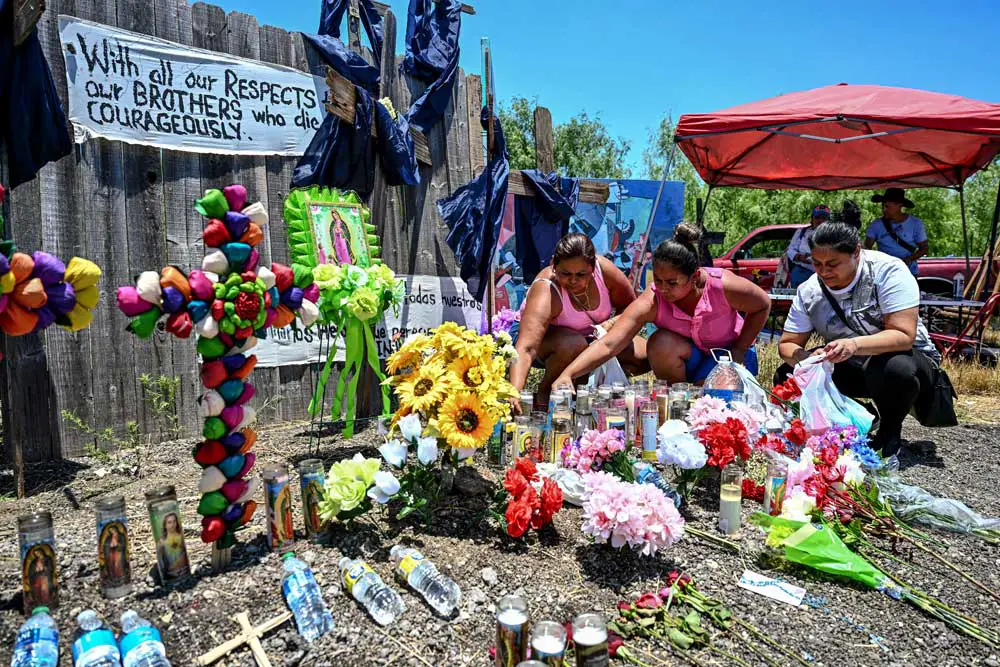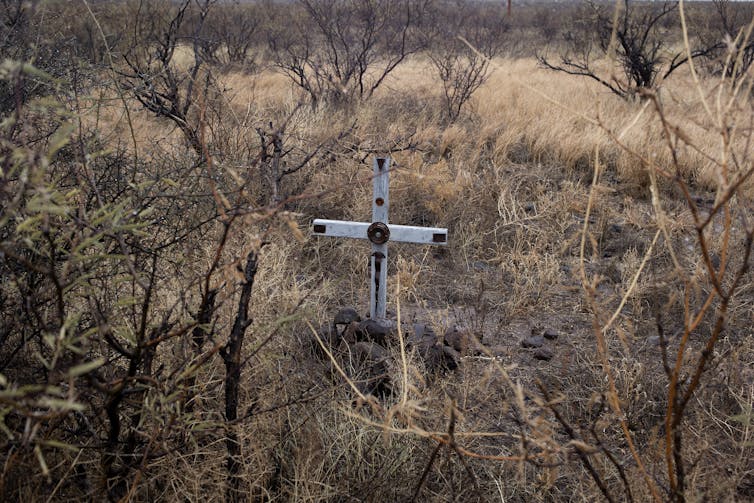
By Joseph Nevin
The June 2022 deaths of 53 people, victims of heat stroke, in the back of a tractor-trailer in San Antonio, Texas, show the dangers of crossing the U.S. southern border without authorization.
All of the dead came from Mexico, Guatemala and Honduras – the three most common origin countries of migrants encountered by the Border Patrol in 2021 and so far in 2022.
Such fatalities result from two intersecting phenomena. One is the massive growth in the federal government’s policing system in the U.S.-Mexico borderlands since the mid-1990s. The other is the strong and profoundly unequal ties between the United States and the home countries of most unauthorized – or undocumented – migrants.
‘Prevention Through Deterrence’
Since 1994, when I began to research the roots and impacts of U.S. border and immigration enforcement, U.S.-Mexico border policing has radically changed. Beginning during Bill Clinton’s presidency, this transformation has involved infusing massive amounts of resources – in the form of personnel, technology and infrastructure – into a multifaceted system of border control.
The number of Border Patrol agents has grown from roughly 4,200 in 1994 to more than 20,000 today. Typically, 80% to 90% of them are stationed in the U.S. Southwest. Spending has increased as well. In 1994, the Border Patrol’s budget was US$400 million. In 2021, it was $4.9 billion – an approximately 700% increase in inflation-adjusted dollars in less than 30 years.
Complementing the growth is a federal border policing strategy called Prevention Through Deterrence. Introduced in 1994, the strategy concentrates policing personnel, surveillance technology and infrastructure in and around border cities and towns. Its goal is to push unauthorized migrants into remote areas characterized by harsh and dangerous terrain, forcing people to abandon their efforts to reach the United States.
As Doris Meissner, Clinton’s head of Immigration and Naturalization Service, later reflected, “We did believe that geography would be an ally to us.”
U.S. officials anticipated that unauthorized border crossings “would go down to a trickle once people realized what it’s like.” Instead, the deterrence policy has compelled migrants to take ever greater risks, resulting in more deaths.
Rising death toll
Traversing the southern borderlands has long proved deadly for migrants.
In the late 1800s, for example, unauthorized Chinese immigrants died in the deserts of the borderlands as they tried to avoid policing associated with the 1882 Chinese Exclusion Act, a law that barred most immigrants from China. And in the 1980s and 1990s, many people, mostly Mexican nationals – sometimes numbering in the hundreds – died annually trying to enter the United States without authorization.
With Prevention Through Deterrence, however, deaths grew markedly.
According to U.S. Border Patrol statistics, there were an average of 359 fatalities annually from fiscal years 1998 to 2021 in the Southwest borderlands. This represents about one death per day over 24 years. Fiscal year 2021 saw 557 fatalities, the highest death toll on record.
Since these deaths occur among a clandestine population, no one knows what percentage of total migrant trips end in tragedy.
But research on the location of human remains does demonstrate that high-tech surveillance towers have pushed migrants to more remote, and more lethal, travel routes beyond the zones of detection.

Andrew Lichtenstein/Corbis via Getty Images
Another dangerous method of unauthorized entry, as seen in San Antonio, involves cramming people into poorly ventilated spaces like the back of a truck. The hope is to transport them across the border and into the U.S. interior undetected by authorities.
The official death tolls cited above are likely severe undercounts. They are based on bodies or human remains that are retrieved. But many corpses are never recovered because of the region’s arduous terrain and enormous size: The U.S.-Mexico boundary is about 2,000 miles long. A combination of bodily decomposition and the scattering of remains by animals further exacerbates the undercounting problem.
The Border Patrol has also failed to include thousands of fatalities in its official counts. According to an April 2022 U.S. Government Accountability Office report, Customs and Border Protection “has not collected and recorded, or reported to Congress, complete data on migrant deaths or disclosed limitations with the data it has reported.”
In the Border Patrol’s Tucson Sector, for example, there were more than twice as many deaths as the agency reported from fiscal year 2015 to 2019, according to the report.
The Mexico-US connection
In 1999, anthropologist Josiah Heyman made a provocative suggestion: “The United States and Mexico are really one unified, if highly unequal, society,” he wrote, “drawn together rather than separated by the border.”
Back then, Mexico was the United States’ second-most important trading partner. It was also the source of 98% of people apprehended by the Border Patrol in the U.S. Southwest. The free movement of people, unlike commercial goods, was not included in NAFTA, the 1994 North American Free Trade Agreement.
Today, one could easily make an observation similar to Heyman’s about Guatemala and Honduras in relation to the United States. Both maintain deep and broad social, political and economic ties with the United States. But those ties are profoundly unequal. The United States also has a history of intervention in Central America that, research shows, directly contributes to the instability and insecurity that set the stage for today’s migration.
In the aftermath of the deaths in San Antonio, U.S. authorities blamed smugglers for the fatalities. President Biden, for instance, said that the deaths “underscore the need to go after the multibillion-dollar criminal smuggling industry preying on migrants.”
Such responses are typical from Washington following such tragedies. But this framing obscures that migrants’ heavy reliance on smugglers is a direct result of the dramatic growth in the federal government’s Southwest border policing system and the associated deterrence strategy. In its official 1994 document outlining the Prevention Through Deterrence strategy, the Border Patrol even included among its “indicators of success” higher fees charged by smugglers and increasingly sophisticated smuggling methods.
In other words, U.S. authorities anticipated growth in the very industry they now decry. Consequently, deaths remain a way of life in the borderlands.
![]()
Joseph Nevins is Professor of Geography at Vassar College




























Dennis C Rathsam says
Its sad so many people have died crossing the border illegally. But our biggest problem is the fentenyol entering our country! Too many of our kids are dead because of China. Its time to stand tall and end this be nice to China policy. Trump led with strenth, all our enemies, China, Iran, Russia, were all afraid of him…Nothing Happened, until they realized they couldnt compete with him so they sent us the China Flu. Now we have an emptey suit in the Whitehouse, and our enemies are on the move. God save America!